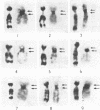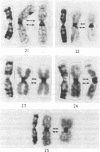Abstract
Banding studies in 25 Robertsonian translocations showed that all could be interpreted as stable dicentrics. The mechanism for their stability is likely to be the proximity of their centromeres but centromeric suppression could also have a role. In many of these dicentric translocations, discontinuous centromeric suppression, as indicated by chromatid separation at one of the centromeric regions, was observed in C-banded preparations. A further observation of undefined relation to the first was that the ratio of the two constitutive centromeric heterochromatin (CCH) regions from the component chromosomes of the translocations was variable in the same translocation type, e.g. t(13;14). It is proposed that this ratio may influence the segregation ratio. Abnormal spermatogenesis is suggested as the likely mechanism for the difference in the proportion of aneuploid offspring in the progeny of maternal and paternal heterozygotes. Neither of the t dic(21;21)s could be interpreted as isochromosomes. It is proposed that Robertsonian fusion translocations be defined as stable, dicentric, whole-arm translocations, with both centromeres in a median position and resulting in the loss of a small acentric fragment during this formation. It is suggested that they occur at high frequency between telocentric or, as in man, certain acrocentric chromosomes because of some intrinsic property of those chromosomes not possessed by metacentric chromosomes and mediated by interphase association of centromeres.
Full text
PDF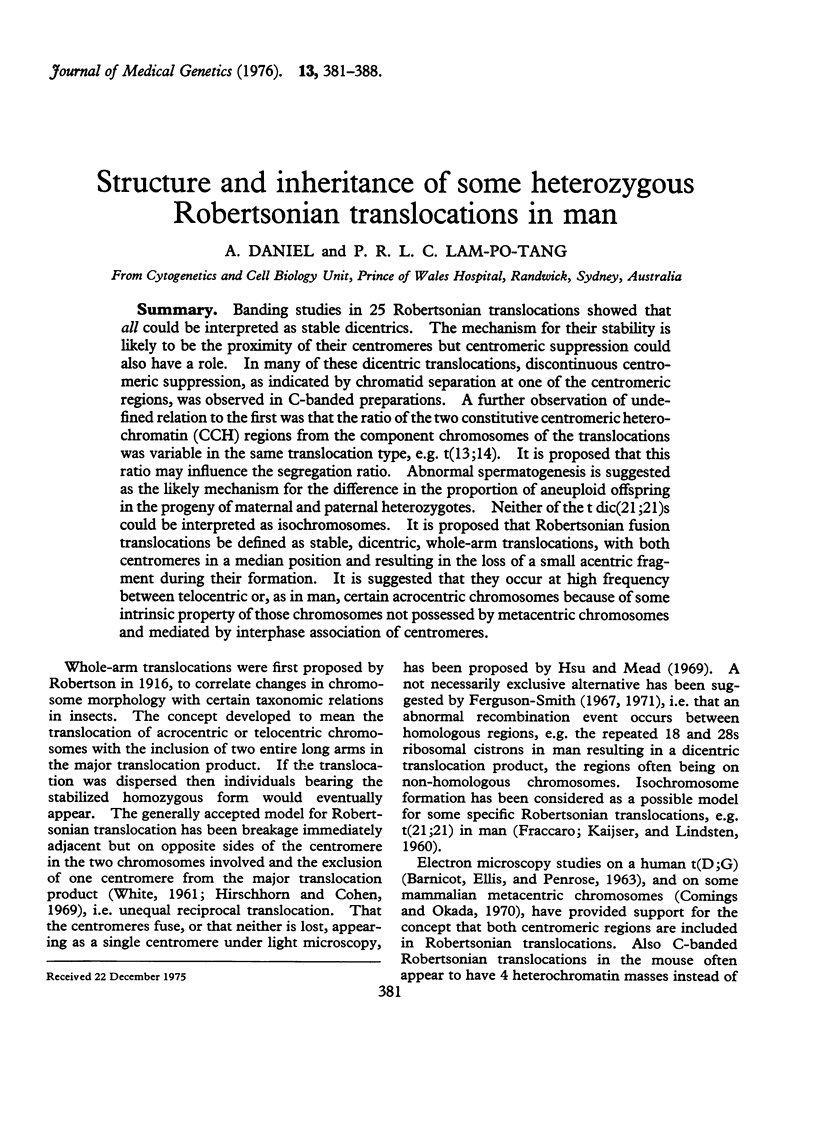
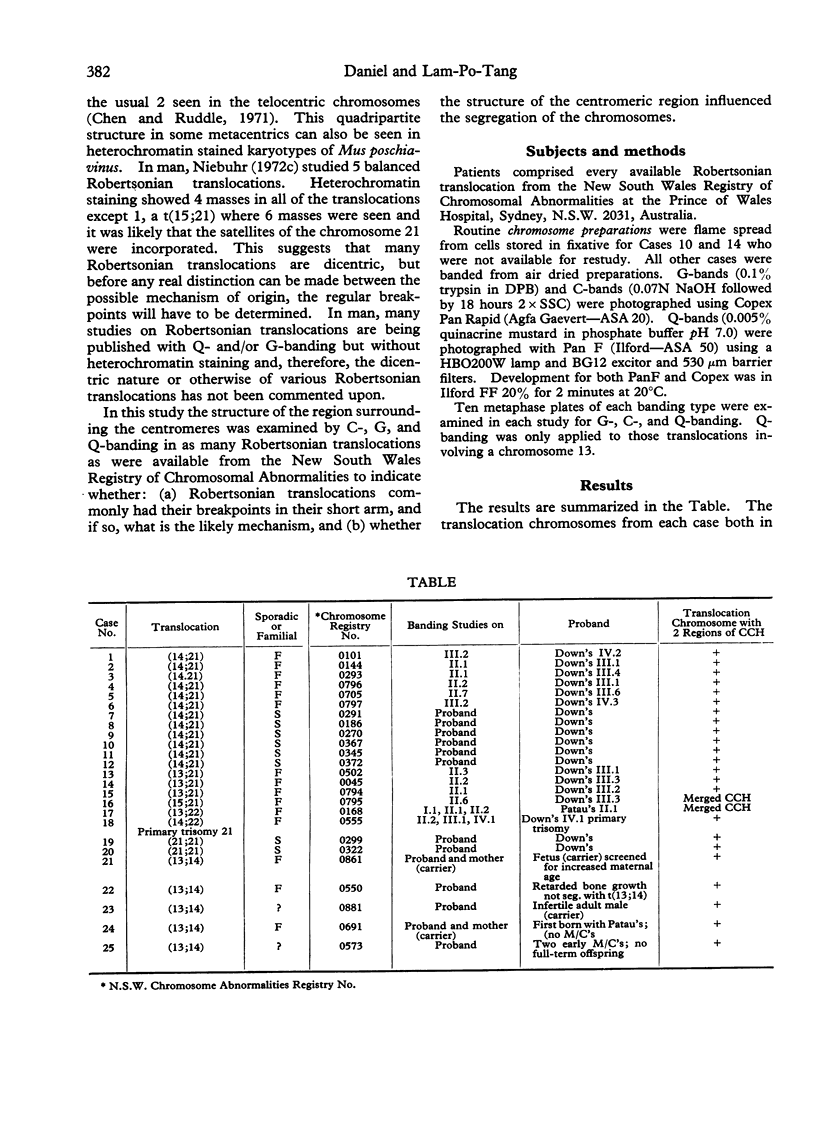
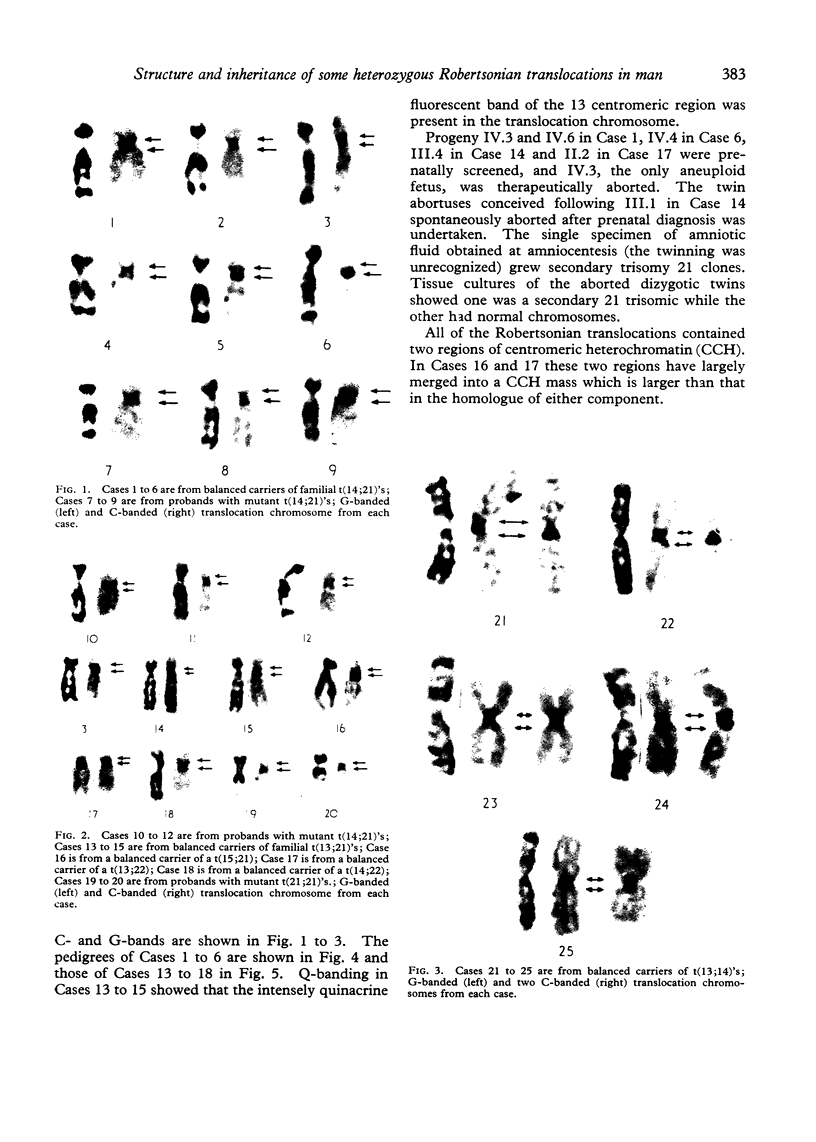
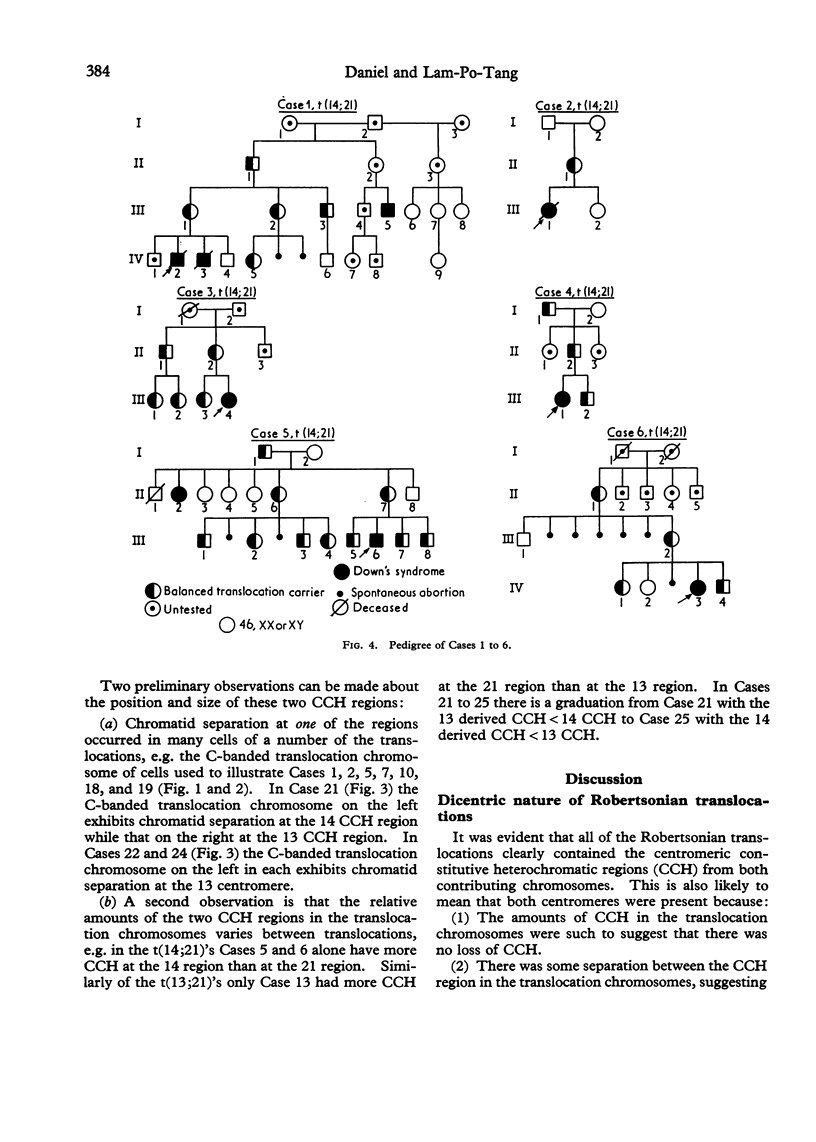
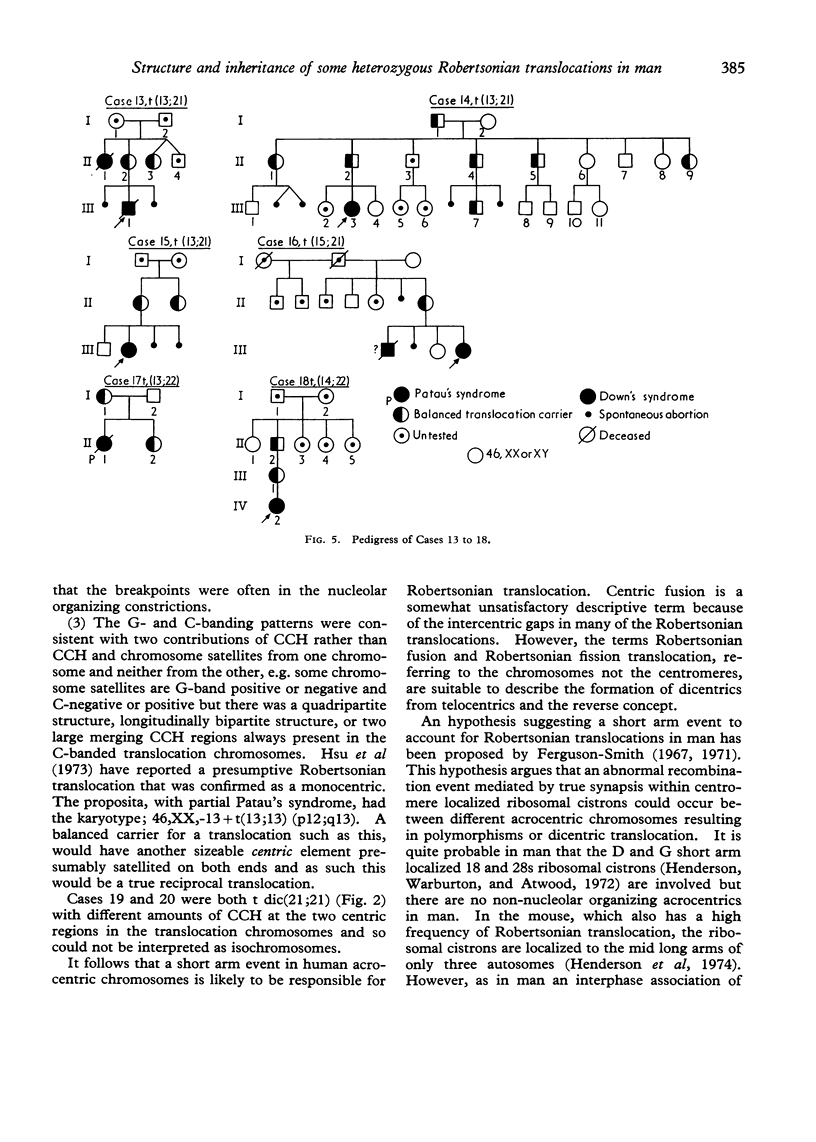
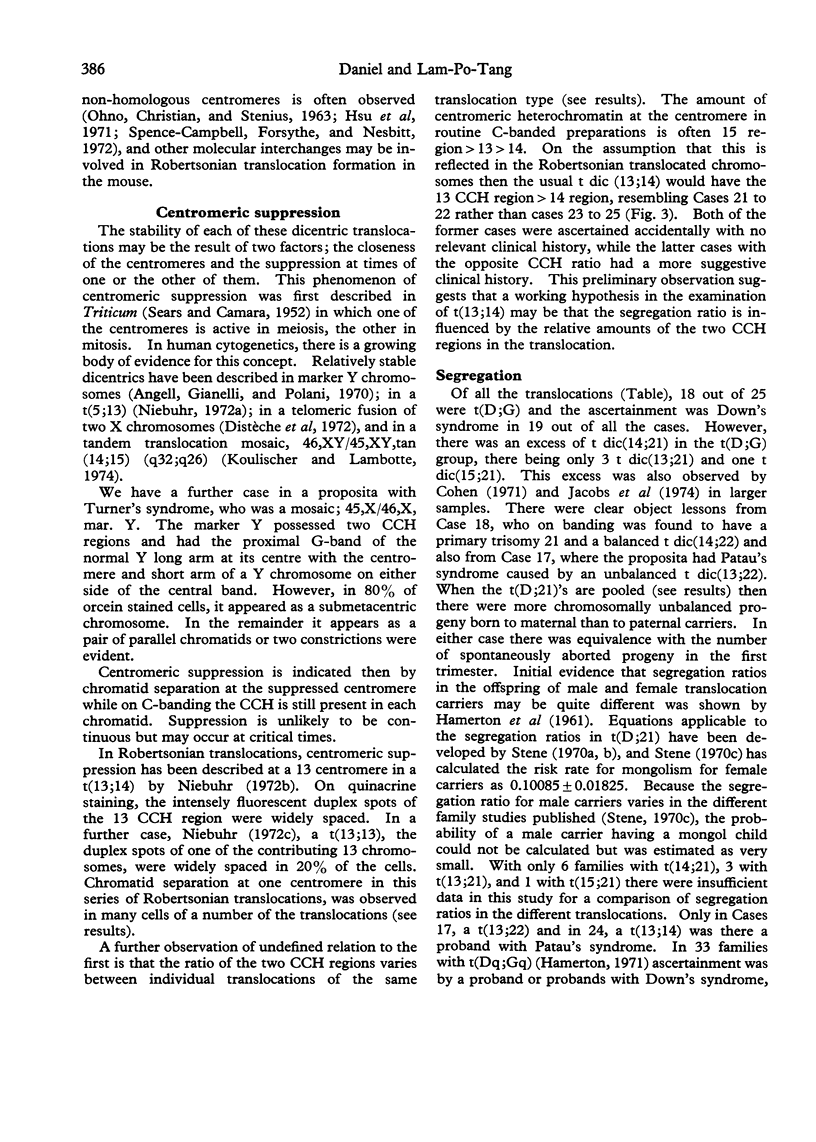
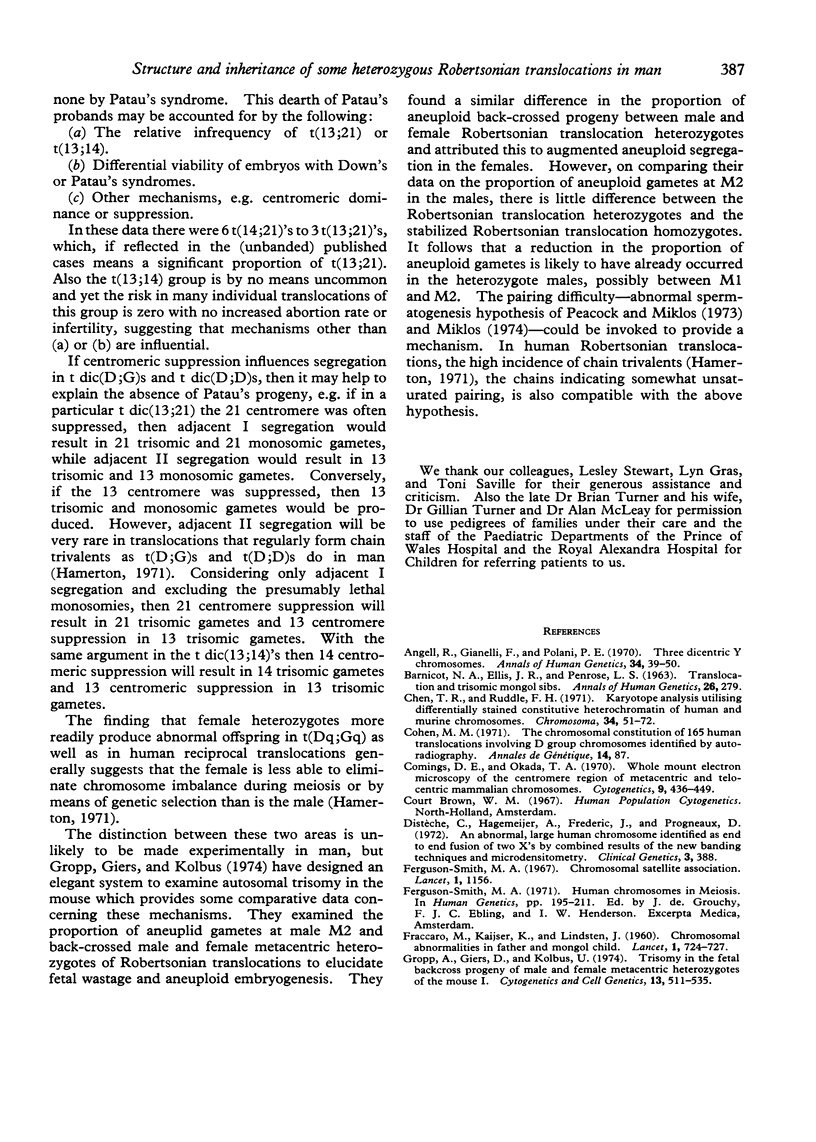
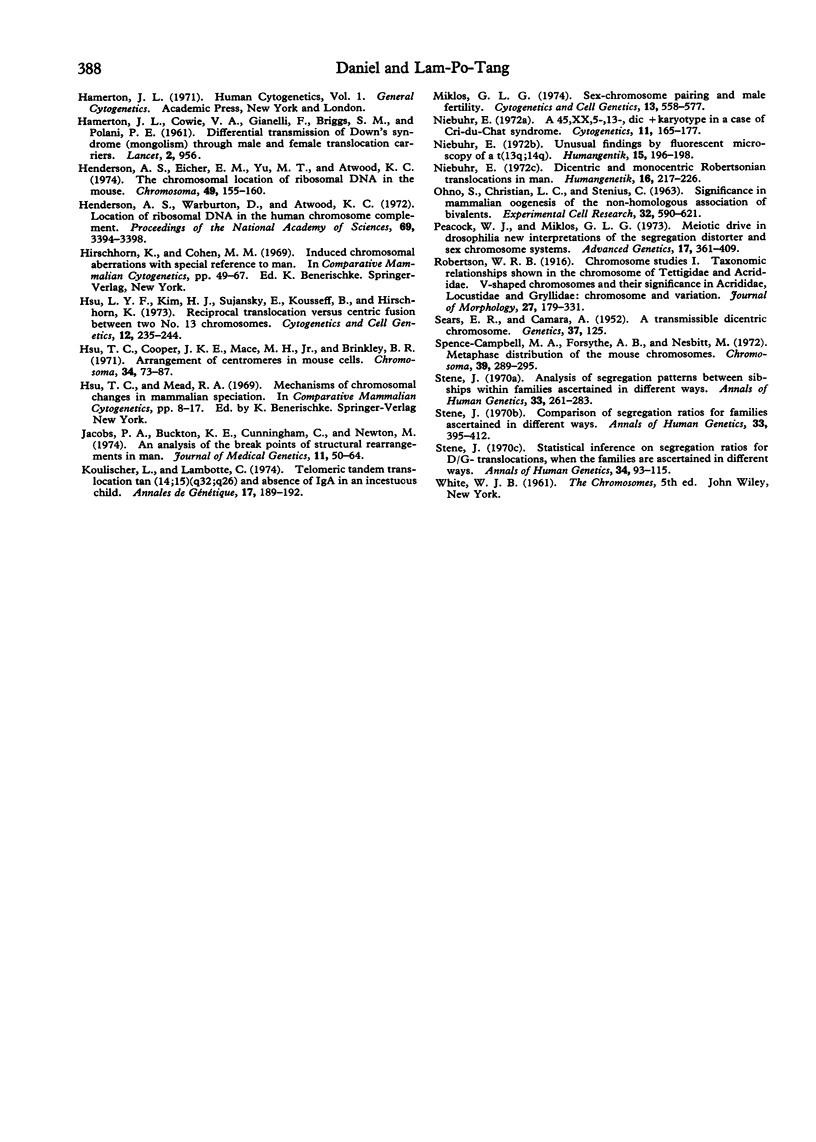
Images in this article
Selected References
These references are in PubMed. This may not be the complete list of references from this article.
- Angell R., Giannelli F., Polani P. E. Three dicentric Y chromosomes. Ann Hum Genet. 1970 Jul;34(1):39–50. doi: 10.1111/j.1469-1809.1970.tb00218.x. [DOI] [PubMed] [Google Scholar]
- BARNICOT N. A., ELLIS J. R., PENROSE L. S. Translocation and trisomic mongol sibs. Ann Hum Genet. 1963 Feb;26:279–285. doi: 10.1111/j.1469-1809.1963.tb01984.x. [DOI] [PubMed] [Google Scholar]
- Chen T. R., Ruddle F. H. Karyotype analysis utilizing differentially stained constitutive heterochromatin of human and murine chromosomes. Chromosoma. 1971;34(1):51–72. doi: 10.1007/BF00285516. [DOI] [PubMed] [Google Scholar]
- Cohen M. M. The chromosomal constitution of 165 human translocations involving D group chromosomes identified by autoradiography. Ann Genet. 1971 Jun;14(2):87–96. [PubMed] [Google Scholar]
- Comings D. E., Okada T. A. Whole-mount electron microscopy of the centromere region of metacentric and telocentric mammalian chromosomes. Cytogenetics. 1970;9(6):436–449. doi: 10.1159/000130113. [DOI] [PubMed] [Google Scholar]
- Distèche C., Hagemeijer A., Frederic J., Progneaux D. An abnormal large human chromosome identified as an end-to-end fusion of two X's by combined results of the new banding techniques and microdensitometry. Clin Genet. 1972;3(5):388–395. doi: 10.1111/j.1399-0004.1972.tb01472.x. [DOI] [PubMed] [Google Scholar]
- FRACCARO M., KAIJSER K., LINDSTEN J. Chromosomal abnormalities in father and Mongol child. Lancet. 1960 Apr 2;1(7127):724–727. doi: 10.1016/s0140-6736(60)90615-2. [DOI] [PubMed] [Google Scholar]
- Gropp A., Giers D., Kolbus U. Trisomy in the fetal backcross progeny of male and female metacentric heterozygotes of the mouse. i. Cytogenet Cell Genet. 1974;13(6):511–535. doi: 10.1159/000130304. [DOI] [PubMed] [Google Scholar]
- HAMERTON J. L., COWIE V. A., GIANNELLI F., BRIGGS S. M., POLANI P. E. Differential transmission of Down's syndrome (mongolism) through male and female translocation carriers. Lancet. 1961 Oct 28;2(7209):956–958. doi: 10.1016/s0140-6736(61)90795-4. [DOI] [PubMed] [Google Scholar]
- Henderson A. S., Eicher E. M., Yu M. T., Atwood K. C. The chromosomal location of ribosomal DNA in the mouse. Chromosoma. 1974;49(2):155–160. doi: 10.1007/BF00348887. [DOI] [PubMed] [Google Scholar]
- Henderson A. S., Warburton D., Atwood K. C. Location of ribosomal DNA in the human chromosome complement. Proc Natl Acad Sci U S A. 1972 Nov;69(11):3394–3398. doi: 10.1073/pnas.69.11.3394. [DOI] [PMC free article] [PubMed] [Google Scholar]
- Hsu L. Y., Kim H. J., Sujansky E., Kousseff B., Hirschhorn K. Reciprocal translocation versus centric fusion between two No. 13 chromosomes. A case of 46,XX,-13,+t(13;13)(p12;q13) and a case of 46,XY,-13,+t(13;13)(p12;p12). Cytogenet Cell Genet. 1973;12(4):235–244. doi: 10.1159/000130459. [DOI] [PubMed] [Google Scholar]
- Hsu T. C., Cooper J. E., Mace M. L., Jr, Brinkley B. R. Arrangement of centromeres in mouse cells. Chromosoma. 1971;34(1):73–87. doi: 10.1007/BF00285517. [DOI] [PubMed] [Google Scholar]
- Jacobs P. A., Buckton K. E., Cunningham C., Newton M. An analysis of the break points of structural rearrangements in man. J Med Genet. 1974 Mar;11(1):50–64. doi: 10.1136/jmg.11.1.50. [DOI] [PMC free article] [PubMed] [Google Scholar]
- Koulischer L., Lambotte C. Telomeric tandem translocation tan (14; 15) (q32; q26) and absence of IgA in an incestuous child. Ann Genet. 1974 Sep;17(3):189–192. [PubMed] [Google Scholar]
- Miklos G. L. Sex-chromosome pairing and male fertility. Cytogenet Cell Genet. 1974;13(6):558–577. doi: 10.1159/000130307. [DOI] [PubMed] [Google Scholar]
- Niebuhr E. A 45,XX,5-,13-,dic+ karyotype in a case of cri-du-chat syndrome. Cytogenetics. 1972;11(3):165–177. doi: 10.1159/000130186. [DOI] [PubMed] [Google Scholar]
- Niebuhr E. Dicentric and monocentric Robertsonian translocations in man. Humangenetik. 1972;16(3):217–226. doi: 10.1007/BF00273467. [DOI] [PubMed] [Google Scholar]
- OHNO S., CHRISTIAN L. C., STENIUS C. SIGNIFICANCE IN MAMMALIAN OOEGENESIS OF THE NON-HOMOLOGOUS ASSOCIATION OF BIVALENTS. Exp Cell Res. 1963 Dec;32:590–592. doi: 10.1016/0014-4827(63)90196-4. [DOI] [PubMed] [Google Scholar]
- Sears E R, Câmara A. A Transmissible Dicentric Chromosome. Genetics. 1952 Mar;37(2):125–135. doi: 10.1093/genetics/37.2.125. [DOI] [PMC free article] [PubMed] [Google Scholar]
- Spence-Campbell M. A., Forsythe A. B., Nesbitt M. Metaphase distribution of the mouse chromosomes. Chromosoma. 1972;39(3):289–295. doi: 10.1007/BF00290788. [DOI] [PubMed] [Google Scholar]
- Stene J. Analysis of segregation patterns between sibships within families ascertained in different ways. Ann Hum Genet. 1970 Jan;33(3):261–283. doi: 10.1111/j.1469-1809.1970.tb01651.x. [DOI] [PubMed] [Google Scholar]
- Stene J. Statistical inference on segregation ratios for D-G-translocations, when the families are ascertained in different ways. Ann Hum Genet. 1970 Jul;34(1):93–115. doi: 10.1111/j.1469-1809.1970.tb00224.x. [DOI] [PubMed] [Google Scholar]



